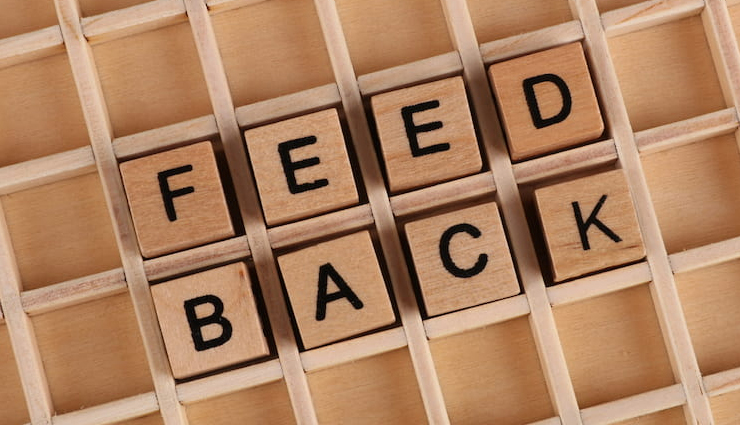- Home›
- Mates & Me›
- Self-Reflection: Understanding Its Importance And 9 Essential Ways To Practice It
Self-Reflection: Understanding Its Importance And 9 Essential Ways To Practice It
By: Priyanka Maheshwari Thu, 29 June 2023 10:33:20

Self-reflection is the process of examining one's thoughts, emotions, actions, and experiences. It involves introspection and gaining insight into oneself. By setting aside dedicated time for self-reflection, engaging in practices such as journaling, meditation, and gratitude, and evaluating past experiences, one can deepen self-awareness, challenge limiting beliefs, and promote personal growth. Self-reflection allows individuals to gain clarity, make positive changes, and cultivate a greater understanding of their values, strengths, weaknesses, and aspirations. It is a valuable tool for self-improvement and achieving a more fulfilling and purposeful life. In this article, we will explore what self-reflection entails and provide 9 essential ways to practice it effectively.

# Set aside dedicated time
Setting aside dedicated time to practice self-reflection is essential for reaping its benefits. By allocating specific moments in your schedule for introspection and self-examination, you create a space for deep thought and self-awareness. During this time, disconnect from distractions and find a calm and quiet environment where you can focus solely on your thoughts and reflections. Whether it's a few minutes each day or a more extended period on a weekly basis, dedicating time to self-reflection allows you to explore your thoughts, emotions, and experiences, gaining valuable insights and promoting personal growth. Make it a priority to carve out this dedicated time, as it is an investment in your own self-discovery and well-being.
# Journaling
Journaling is a powerful and accessible way to practice self-reflection. It involves writing down your thoughts, feelings, experiences, and observations in a journal or notebook. By putting your thoughts on paper, you create a tangible record that allows for deeper introspection and self-examination. Here are some tips for using journaling as a tool for self-reflection:
Make it a habit: Set aside regular time for journaling, whether it's daily, weekly, or whenever you feel the need to reflect. Consistency is key to developing a reflective practice.
Write freely: When journaling for self-reflection, let your thoughts flow without judgment or censorship. Write whatever comes to mind, allowing yourself to explore your emotions, concerns, and insights.
Reflect on experiences: Write about significant events, experiences, or interactions that have impacted you. Reflect on how they made you feel, what you learned from them, and how they relate to your personal growth.
Ask yourself questions: Pose thought-provoking questions to guide your reflections. Consider questions such as "What are my core values?" or "What do I need to let go of to move forward?" These prompts can help deepen your self-understanding.
Explore emotions: Pay attention to your emotions and use your journal as a safe space to explore them. Describe how you feel, what triggers certain emotions, and how they influence your thoughts and actions.
Seek patterns: Review your journal entries periodically and look for recurring themes or patterns. Identify commonalities in your thoughts, feelings, or behavior, which can provide valuable insights into your personal tendencies.
Celebrate accomplishments: Acknowledge your achievements and milestones in your journal. Reflect on what you have accomplished, what you are proud of, and the progress you have made. This practice cultivates gratitude and self-appreciation.
Practice self-compassion: Be kind to yourself as you engage in self-reflection through journaling. Avoid self-judgment or harsh criticism. Treat yourself with compassion and understanding, offering support and encouragement.

# Meditate
Meditation is a powerful practice that can enhance self-reflection and promote deep introspection. By incorporating meditation into your routine, you create a space for quiet contemplation and inner awareness. Here's how you can use meditation as a tool for self-reflection:
Find a quiet space: Choose a peaceful environment where you can meditate without distractions. Create a space that feels calm and comfortable, allowing you to focus inward.
Set a time limit: Start with a manageable duration for your meditation practice, such as 5 or 10 minutes, and gradually increase it as you become more comfortable. This helps ensure consistency and establishes a routine.
Get into a comfortable posture: Sit in a position that supports alertness and relaxation, whether it's on a cushion, a chair, or the floor. Keep your spine straight, shoulders relaxed, and hands resting comfortably.
Focus on your breath: Direct your attention to the sensation of your breath as it enters and leaves your body. Notice the rise and fall of your abdomen or the coolness and warmth of the air as you inhale and exhale.
Cultivate mindfulness: Allow thoughts, emotions, and sensations to arise without judgment or attachment. Observe them as they come and go, maintaining a non-reactive and non-judgmental attitude. Notice any patterns or recurring themes in your thoughts.
Explore your inner landscape: During meditation, take the opportunity to delve deeper into your thoughts, feelings, and inner experiences. Observe the content of your mind without getting caught up in it. Reflect on your emotions, desires, and aspirations.
Practice self-inquiry: Engage in reflective questions during your meditation practice. Ask yourself meaningful questions that foster self-understanding and self-discovery. Examples include "Who am I beyond my thoughts and emotions?" or "What truly matters to me in life?"
Embrace silence and stillness: Allow moments of silence and stillness in your meditation practice. By creating space for stillness, you provide an opportunity for insights and deeper self-awareness to arise.
Maintain a regular practice: Consistency is key in reaping the benefits of meditation for self-reflection. Aim to meditate daily or as frequently as possible, even if it's for short periods. Regular practice deepens your connection with yourself and enhances self-reflection.
# Practice gratitude
Practicing gratitude is a powerful way to enhance self-reflection and deepen your self-awareness. By cultivating a grateful mindset, you create a positive foundation for introspection and gain a greater understanding of yourself and the world around you. Here's how you can use gratitude to enhance your self-reflection practice:
Begin with gratitude: Before diving into self-reflection, take a few moments to express gratitude for the blessings, experiences, and relationships in your life. Acknowledge the things you appreciate and the people who have made a positive impact on your journey.
Reflect on moments of gratitude: During your self-reflection practice, intentionally reflect on the moments that brought you joy, contentment, or a sense of gratitude. Recall experiences, achievements, or interactions that you are grateful for and explore the emotions associated with them.
Journal your gratitude: Incorporate gratitude journaling into your self-reflection practice. Write down a few things you are grateful for each day or reflect on specific moments of gratitude in your life. This process deepens your awareness of the positive aspects and fosters a grateful perspective.
Appreciate personal growth: When reflecting on your personal journey, take time to appreciate your growth and progress. Acknowledge the challenges you have overcome, the lessons you have learned, and the strengths you have developed along the way. Embrace gratitude for your personal transformation.
Find gratitude in difficulties: While reflecting on challenges or setbacks, seek gratitude in the lessons and growth opportunities they provided. Explore how these experiences shaped you, strengthened your resilience, or redirected your path. Gratitude can help shift your perspective and find silver linings in difficult times.
Express gratitude to others: Use self-reflection as an opportunity to express gratitude to the people who have supported, inspired, or influenced you. Write letters, send messages, or have heartfelt conversations to convey your appreciation. Gratitude shared with others deepens connections and fosters a sense of gratitude within yourself.
Cultivate a gratitude mindset: Infuse your self-reflection practice with an ongoing attitude of gratitude. Approach each moment with an open heart, seeking opportunities to recognize and appreciate the blessings, experiences, and growth that come your way. Embrace gratitude as a way of life.

# Seek feedback
Seeking feedback from others is an invaluable practice that can greatly enhance your self-reflection journey. By inviting input and perspectives from trusted individuals, you gain valuable insights, challenge your assumptions, and deepen your self-awareness. Here's how you can effectively seek feedback to support your self-reflection practice:
Identify trusted sources: Choose individuals who you respect and trust to provide honest and constructive feedback. They could be mentors, friends, family members, or colleagues who have a good understanding of your strengths and areas for growth.
Specify areas for feedback: Clearly communicate the specific aspects or areas of your life that you would like feedback on. This could include your communication style, decision-making process, work performance, or personal relationships. Focusing on specific areas helps to ensure targeted feedback.
Create a safe and supportive environment: Encourage open and honest communication by creating a safe space for feedback. Assure the person giving feedback that their input will be received with an open mind and without defensiveness. Foster a supportive environment that encourages genuine and constructive dialogue.
Ask open-ended questions: Frame your requests for feedback using open-ended questions that encourage thoughtful and detailed responses. For example, ask questions like "What are some areas you think I can improve on?" or "How do you perceive my communication style?" These types of questions prompt deeper reflection and provide more valuable insights.
Listen actively and without judgment: When receiving feedback, practice active listening. Truly hear and understand what the other person is saying without interrupting or becoming defensive. Maintain an open mind and suspend judgment, allowing yourself to absorb the feedback fully.
Seek clarifications and examples: If certain feedback points are not clear or you require further context, don't hesitate to ask for clarifications or examples. Seek a deeper understanding of the feedback to ensure you can effectively reflect upon it.
Reflect on the feedback: Take time to reflect on the feedback you receive. Set aside dedicated moments to process and evaluate the information provided. Consider how the feedback aligns with your own self-perception and identify areas where you can make improvements.
Recognize patterns and themes: Look for recurring patterns or themes in the feedback you receive from different sources. Identifying common threads can provide valuable insights into your strengths, blind spots, and areas for growth.
Separate the feedback from your self-worth: Remember that feedback is meant to help you grow and develop, not to judge your worth as a person. Detach your self-esteem from the feedback and view it as an opportunity for self-improvement.
Take action: Based on the feedback you receive, identify specific actions you can take to make positive changes or further develop your skills. Set goals and create an action plan to address the areas highlighted in the feedback.
# Engage in self-questioning
Engaging in self-questioning is a powerful technique to deepen your self-reflection practice. By asking yourself thought-provoking and introspective questions, you encourage a deeper exploration of your thoughts, emotions, beliefs, and actions. Here are some key steps to effectively engage in self-questioning for self-reflection:
Create a reflective space: Find a quiet and comfortable space where you can engage in self-questioning without distractions. This could be a dedicated area in your home or a serene outdoor environment that allows for deep introspection.
Set an intention: Before diving into self-questioning, set a clear intention for your reflection. Decide what specific aspect of your life or self you want to explore and gain insight into. This could range from your values and goals to your emotions and relationships.
Be open and non-judgmental: Approach self-questioning with an open mind, free from self-judgment or criticism. Embrace curiosity and a sense of wonder as you delve into your thoughts and emotions. Allow yourself to explore without preconceived notions.
Ask open-ended questions: Craft open-ended questions that encourage deep reflection and self-exploration. Avoid questions that have simple "yes" or "no" answers. Instead, focus on questions that prompt thoughtful responses and encourage introspection.
Examples of self-reflective questions: Here are some examples of self-reflective questions to get you started:
What are my core values and how do they align with my actions?
What are my strengths and how can I leverage them for personal growth?
What are my biggest fears or limiting beliefs, and how do they hold me back?
How do I respond to challenges or setbacks, and what can I learn from them?
How do I contribute to my relationships, and how can I improve them?
What brings me joy and fulfillment, and how can I incorporate more of it into my life?
What are my long-term goals, and what steps can I take to move closer to them?

# Evaluate past experiences
Evaluating past experiences is a valuable practice for self-reflection as it allows you to gain insights, learn from your successes and failures, and make informed choices moving forward. Here are the steps to effectively evaluate past experiences for self-reflection:
Identify the experiences: Begin by identifying the specific experiences you want to evaluate. They can be recent or from a distant past, and they may involve personal, professional, or social aspects of your life.
Reflect on the context: Consider the circumstances surrounding the experiences. Reflect on the people involved, the environment, and any factors that may have influenced the outcomes. Understanding the context provides a broader perspective for your evaluation.
Identify the outcomes: Evaluate the outcomes of the experiences. Consider both the positive and negative aspects, and reflect on how they have impacted your life, growth, and well-being. Look for lessons learned, insights gained, and areas for improvement.
Analyze your actions: Assess your own thoughts, decisions, and actions during those experiences. Were there any patterns or habits that contributed to the outcomes? Examine your mindset, motivations, and behaviors to gain a deeper understanding of your role in those situations.
Recognize strengths and weaknesses: Identify your strengths and weaknesses that were evident in those experiences. Reflect on how your strengths positively contributed to the outcomes and consider how your weaknesses may have influenced certain aspects. This self-awareness helps you leverage your strengths and work on areas that require improvement.
Extract lessons and insights: Look for key lessons and insights that you can draw from the experiences. Consider what worked well and what didn't. Identify the skills, knowledge, or mindset shifts that can be carried forward to future situations. These lessons become valuable guidance for personal growth and decision-making.
Consider alternative perspectives: Challenge your own perspective by considering alternative viewpoints or interpretations of the experiences. How might others have perceived the situations? This exercise broadens your understanding and helps you develop empathy and a more balanced outlook.
Apply the insights: Take the lessons and insights gained from the evaluation and apply them to your present and future actions. Consider how you can use this newfound knowledge to make better choices, improve relationships, or achieve your goals. Use the evaluation as a catalyst for personal growth and positive change.
Continuously review and refine: Self-reflection is an ongoing process. Regularly review and refine your evaluation of past experiences as you gain new insights or as circumstances change. Adapt your understanding and use the lessons learned to refine your approach in different areas of your life.
# Embrace solitude
Embracing solitude is a powerful practice that allows you to disconnect from external distractions and cultivate a deeper connection with yourself. Solitude provides a space for self-reflection, introspection, and personal growth. Here's how you can embrace solitude to practice self-reflection effectively:
Create intentional alone time: Set aside dedicated periods of time for solitude in your schedule. It can be a few minutes each day or longer periods on a weekly or monthly basis. Make it a priority to create this space for yourself.
Find a peaceful environment: Choose a quiet and serene environment where you can be alone with your thoughts. It could be a peaceful room in your home, a natural setting, or any place where you feel comfortable and free from distractions.
Disconnect from technology: During your solitude practice, disconnect from electronic devices and external distractions. Turn off your phone or put it on silent mode to eliminate interruptions. Allow yourself to fully immerse in the present moment.
Engage in activities that promote reflection: Use your solitude time to engage in activities that facilitate self-reflection. This can include journaling, meditating, taking walks in nature, practicing deep breathing exercises, or engaging in creative pursuits like painting or writing.
Cultivate mindfulness: Embrace the practice of mindfulness during your moments of solitude. Focus on the present moment, observing your thoughts, emotions, and sensations without judgment. Stay fully aware of your inner experiences.
Explore your thoughts and emotions: Allow your mind to wander and explore your thoughts and emotions. Observe any recurring patterns, beliefs, or concerns that arise. Reflect on your experiences, challenges, and aspirations.
Practice active listening to your inner voice: Listen attentively to your inner voice during moments of solitude. Tune into your intuition and inner wisdom. Pay attention to the insights and guidance that arise from within.
Embrace silence and stillness: Embracing silence and stillness in solitude allows you to connect with your inner self on a deeper level. Find comfort in the absence of external noise and distractions. Allow the silence to nourish your mind and soul.
Be gentle with yourself: During solitude, practice self-compassion and self-acceptance. Be kind and patient with yourself as you explore your thoughts and emotions. Embrace solitude as a nurturing space for self-care and self-discovery.
Reflect and integrate insights: After your solitude practice, take time to reflect on the insights and experiences you gained. Consider how they can be integrated into your daily life and decision-making. Use these insights to guide your personal growth and actions.

# Practice active listening
Practicing active listening is a valuable technique that can enhance your self-reflection practice. By actively listening to your inner voice, thoughts, and emotions, you develop a deeper understanding of yourself and foster self-awareness. Here's how you can incorporate active listening into your self-reflection:
Create a quiet and focused environment: Find a calm and distraction-free space where you can engage in active listening. Minimize external disturbances and create an atmosphere conducive to introspection.
Cultivate presence: Bring your full attention to the present moment. Let go of distractions and be fully present with yourself. This allows you to actively listen to your internal experiences without being preoccupied with external influences.
Notice your thoughts and emotions: Observe your thoughts and emotions as they arise without judgment. Allow them to flow without attachment or resistance. Notice any recurring patterns or themes that emerge during your self-reflection.
Engage in reflective questioning: Ask yourself meaningful questions that prompt self-reflection. Listen to your inner responses and give them space to unfold. Examples include "What am I feeling in this moment?" or "What are the underlying beliefs driving my actions?"
Practice non-judgment and acceptance: Approach your thoughts and emotions with a non-judgmental attitude. Accept them for what they are without labeling them as good or bad. This creates a safe space for deeper self-exploration.
Embrace silence: Embrace moments of silence in your self-reflection practice. Silence allows you to listen to the subtle inner messages and insights that arise. Resist the urge to fill the silence with external noise or distractions.
Notice bodily sensations: Pay attention to the sensations in your body as you engage in self-reflection. Listen to the physical cues and signals your body provides. Body sensations often carry valuable information about your emotional state and inner experiences.
Validate your experiences: Acknowledge and validate your own experiences. Listen to yourself with empathy and compassion. Validate your thoughts, emotions, and experiences as valid and worthy of attention.
Reflect on your self-talk: Notice your internal dialogue and self-talk. Listen to the tone and content of your self-talk and identify any negative or self-limiting patterns. Reframe negative self-talk into more empowering and positive affirmations.
Learn from your inner wisdom: Cultivate trust in your inner wisdom and intuition. Listen to the deeper insights and guidance that arise during self-reflection. Allow this inner wisdom to inform your choices and actions.





